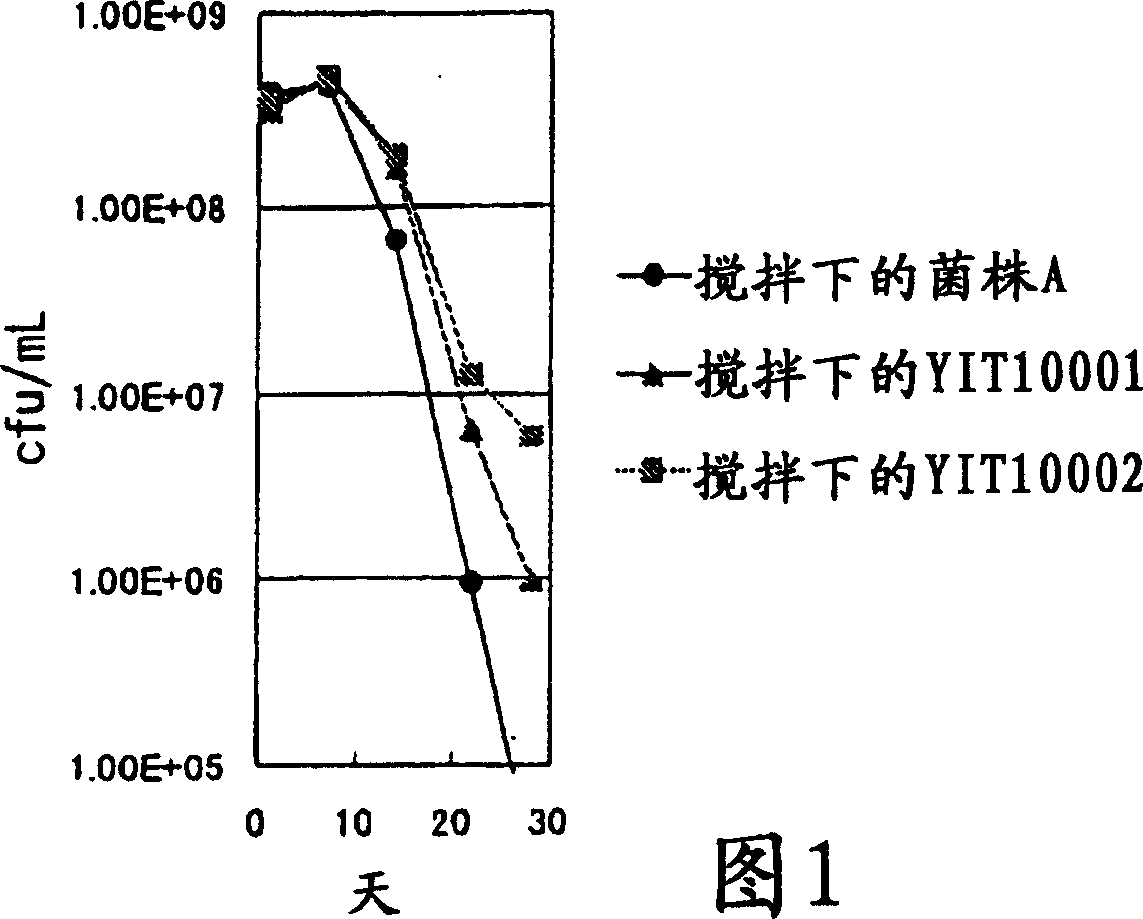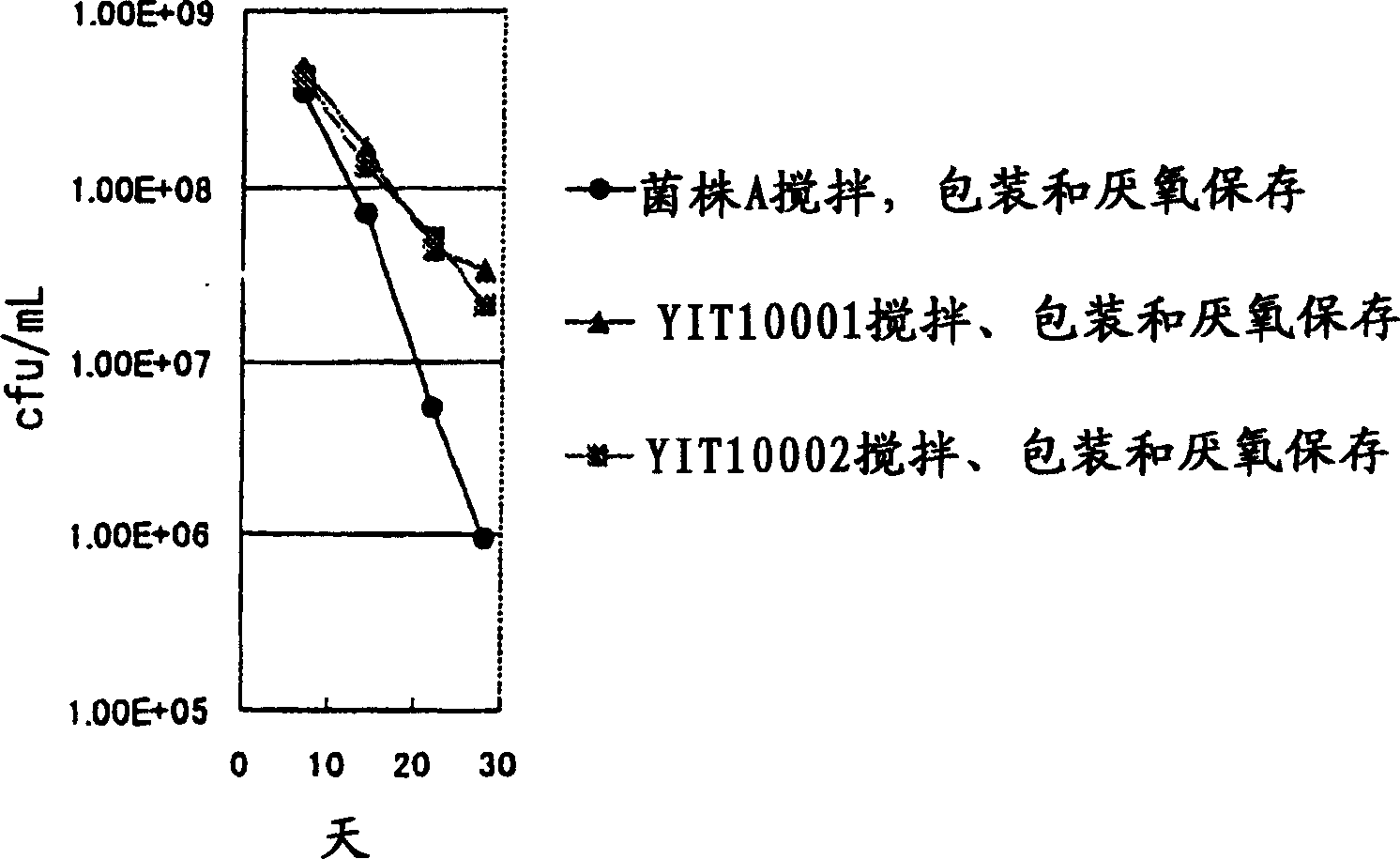Bacterium of the genus bifidobacterium and fermented foods using the same
A bifidobacteria, fermented food technology, applied in bifidobacteria, methods of using bacteria, applications, etc., can solve problems such as difficulty in bacterial strains, and achieve the effect of high survival rate
- Summary
- Abstract
- Description
- Claims
- Application Information
AI Technical Summary
Problems solved by technology
Method used
Image
Examples
Embodiment 1
[0045] Parent strain A, Bifidobacterium breve strain (YIT 4065: FERM BP-6223, was deposited in the International Patent Biological Deposit Center of the National Institute of Advanced Industrial Science and Technology (ChuoNo.6, 1-1, Higashi- 1-chome, Tsukuba, Ibaraki, 305-8566 Japan) (cephalothin (cephalothin)-streptomycin-resistant strain) and Lactococcus lactis were inoculated into a medium containing 20% skimmed milk and mixed at 37°C for 24 hour to prepare the bacterial solution. Add the Streptococcus salivarius subsp. Syrup solution to a final concentration of 5% to prepare fermented milk products. The fermented milk products are poured into glass bottles, plugged with cotton plugs during storage, and stirred with a stirrer under an aerobic environment. Under this condition, the bottles are in the Store at 10°C for 2 weeks. Spread live bacteria on the medium and isolate 2,000 single colonies.
[0046] A fermented milk product was prepared by the same method as above u...
Embodiment 2
[0061] Survival assay
[0062] Bifidobacterium breve YIT 10001, YIT 10002 and strain A, which are bacteria belonging to the genus Bifidobacterium, were used to prepare fermented milk products.
[0063] Specifically, 2 liters of 20% milk medium was injected into a 2.5 liter fermenter, and the above bacterial strains belonging to the genus Bifidobacterium and Lactococcus lactis YIT 2027 were inoculated as seed starters at concentrations of 2% and 0.01%, respectively , and cultured at 37° C. for 24 hours to prepare a bacterial solution by homogenizing at 15 MPa. Streptococcus salivarius subsp. thermophilus was cultured in 20% skimmed milk at 37°C for 20 hours to prepare bacterial solutions by homogenizing at 15 MPa. These bacterial solutions were mixed in a ratio of 1:2, and a syrup solution containing reduced viscous maltose syrup was added to a final concentration of 5% to prepare a fermented milk product (viable bacteria count: bacterial strain A 5.65×10 8 cfu / ml, YIT 10001 ...
Embodiment 3
[0067] Inject 2 liters of 24% milk medium into a 2.5 liter fermenter. Bifidobacterium breve YIT 10001 and Lactococcus lactis YIT 2027 seed primers were inoculated at concentrations of 2% and 0.01%, respectively, and cultured at 37° C. for 24 hours to prepare bacterial solutions by stirring at 15 MPa. The seed primers of Lactobacillus casei and Lactobacillus acidophilus were each inoculated into 20% skimmed milk at a concentration of 0.5%, cultivated at 37° C. for 24 hours, and prepared a bacterial solution by stirring at 15 Mpa. These bacterial solutions were mixed in a ratio of 2:3, and the syrup solution containing isomaltulose was added to a final concentration of 10% to prepare fermented milk products (the initial viable count of YIT 10001: 5.76×10 8 cfu / ml).
[0068] Among the fermented milk products, YIT 10001 exhibited a survival rate of 30% or more after being stored with stirring at 10° C. for 2 weeks in the same manner as in Example 1. The taste is excellent, too. ...
PUM
 Login to View More
Login to View More Abstract
Description
Claims
Application Information
 Login to View More
Login to View More - R&D
- Intellectual Property
- Life Sciences
- Materials
- Tech Scout
- Unparalleled Data Quality
- Higher Quality Content
- 60% Fewer Hallucinations
Browse by: Latest US Patents, China's latest patents, Technical Efficacy Thesaurus, Application Domain, Technology Topic, Popular Technical Reports.
© 2025 PatSnap. All rights reserved.Legal|Privacy policy|Modern Slavery Act Transparency Statement|Sitemap|About US| Contact US: help@patsnap.com


